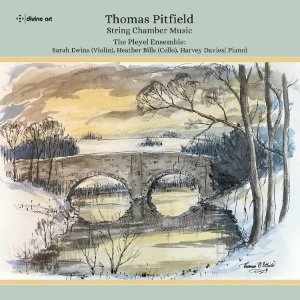
Thomas Pitfield (1903-1999)
Piano Trio No.1 in C major (1930)
Piano Trio No.2 in F minor Lyric (1948/1949)
Epigraph for violin, cello and piano (undated)
Sonatina for cello and piano (1955)
Sonata in D minor for cello and piano (1937/1938, publ. 1949)
The Pleyel Ensemble
rec. 2023, Carole Nash Recital Room, Royal Northern College of Music, Manchester, UK
Divine Art DDX21137 [61]
One needs to know that Thomas Baron Pitfield was a polymath: not only a prolific and skilled composer, but an artist, poet, teacher, author, cabinetmaker and ornithologist. It has been said that he hid many more lights under his bushel. To be sure, he is not one of the “towering giants” of British music. On the other hand, he has been unfairly ignored on the wider stage of concert halls and recital rooms. I had noted earlier that I enjoyed, and genuinely warmed to, the pieces of his which I heard.
Stylistically, Pitfield is hard to define. Frederick Delius, Ralph Vaughan Williams and Percy Grainger may spring to mind. He makes use of folk song, and adapts it to his own classical style. To my knowledge, he never indulged in dodecaphony or flirted with the avant-garde. His compositions always have tuneful melodies, interesting harmonies and a strong understanding of instrumentalists’ needs.
I began with the bewitching Sonatina for cello and piano. John Turner’s liner notes say that the “cello was Thomas Pitfield’s own instrument, and he received lessons in his youth from the cellist Katherine Moorhouse, the first wife of the Manchester composer Eric Fogg (Uncle Eric of BBC’s Children’s Hour), both of whom became hospitable friends to Pitfield.” He dedicated the Sonatina to the onetime Principal Cellist of the Hallé Orchestra, Oliver Vella, and to Oliver’s wife Sheila. It is delightful, with inventive moments especially in the opening Allegro risoluto and the dreamy Arietta. At just shy of eleven minutes, the sonatina is not a didactic miniature. The tyro would need a strong technique to give a good account, especially of the concluding Toccatina. The two soloists here give an impressive performance.
The liner notes sadly do not comment on the Sonata for cello and piano in D minor. The opening Variations contain Rachmaninovian pianism, counterpointed to more “English”-sounding passagework. The piece is eclectic – to its detriment, as some may argue. I loved the dreamy Pastoral Interlude, where echoes of Delius abound, with significant effect. Other stylistic models follow in the ‘middle eight’. I can imagine Pitfield exploring his beloved Dunham Massey, a great park south of Manchester. The Sonata is rounded off with a folksy Allegro Epilogue. Are there nods to a well-known Christmas carol in these pages? It is hard to understand why – like so much British music – this splendid sonata is not in the standard repertoire.
The short Epigraph for violin, cello and piano is based on “fragments from an ostinato by the Russian composer Arensky, written for The Arensky Trio”. It is a thoughtful, pensive little number.
Ever since my introduction in 1977 to Schubert’s Piano Trio in B flat major, op.100, I have been an enthusiast of the genre – especially, I must add, trios devised by British composers. Pitfield’s dedicated the Piano Trio No.1 in C major to his wife-to-be, Alice M Astbury. The New London Trio premiered it on 16 March 1933 at an Oxford University Press private concert.
It is difficult to pin down the sound world of this piece. It is by turns pastoral, romantic and edging towards an incipient modernism, especially in the final movement. Here and there, a folk tune emerges and then is cast aside. Yet this is not cow-and-gate music, despite debt to several then-contemporary composers, including RVW, and to York Bowen’s pianism. The liner notes explains that “this substantial and serious early work is in a much more harmonically advanced style than his later music, and exhibits few of the distinctive footprints of his later works”. Enjoyable and deeply felt, the Trio enchants but does not seriously challenge.
The Arensky Trio gave the premiere performance of the Piano Trio No.2 in F minor at a concert celebrating Pitfield’s 80th birthday, on 6 May 1983 at All Saints Church, Altringham. John Turner notes that it remains unpublished. Despite the Lyric soubriquet, it is rather astringent in mood, but not difficult to listen to.
The opening Allegro marcato uses a bouncy folklike theme, whose title is always just on the tip of the tongue. The two-part second movement opens with a long Larghetto solenne theme for solo piano, before it turns into a beguiling scherzo, marked Allegro quasi allegretto, for all the players. The piano dominate again for a number of bars before the movement concludes melancholically. The Allegro marcato finale fairly bounces along, with lots of extravagant pianism and vivid string playing. Here and there, a quieter interlude tries to impose itself, with little success. This characteristically “molto perpetuo” movement concludes in quiet reflection.
The well produced booklet could have offered a little more analysis and commentary on the works. There is a good introduction to the composer, and notes on the performers. The cover sports the evocative watercolour Weaver Bridge at Church Minshull, Cheshire, from the garden of Weaver Cottage, a fine example of Pitfield’s achievement as an artist.
There is nothing to compare the performances to. No matter: they exude brilliance, technical competence and a sympathetic understanding of Pitfield’s music. The recording is clear and vibrant.
I hope the disc succeeds in introducing these attractive works to a wide audience, including other piano trio ensembles. The blurb is spot on: “This album offers a glimpse into Pitfield’s artistic vision and craftsmanship. Pitfield’s compositions are filled with elegance, lyricism, and emotional depth.”
John France
If you purchase this recording using a link below, it generates revenue for MWI and helps us maintain free access to the site



















